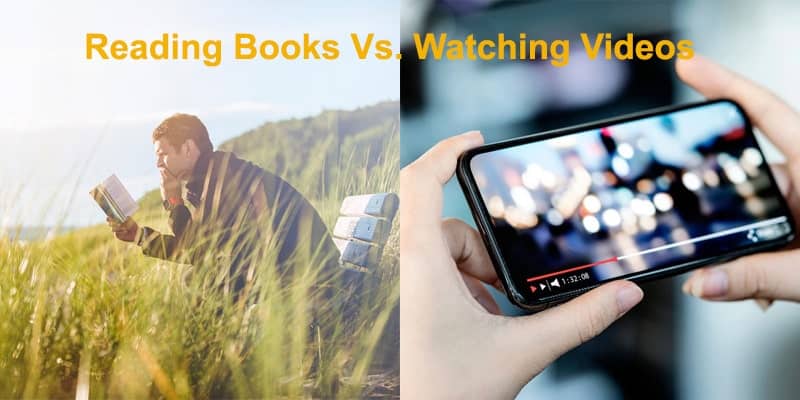With the introduction of new technology, watching videos has become a popular trend, challenging the traditional reading culture. These advancements are revolutionising the way information is presented, putting books in direct competition. Before the emergence of video technology, reading science, or the science of reading, was the dominant form of obtaining information, and books were hailed as the most reliable, convenient, and accurate medium.
This promoted a widespread reading culture. Libraries, found in almost every town, served as the usual place to access books. In fact, it was common for homes and institutions to have their own collections, as people recognized the value of learning from books. Undoubtedly, books have long been revered as one of the most popular sources of information. However, as technology advances, so does our way of learning.
Website content is preferred over video content.

Though nowadays video content has its own value, some people prefer website content. Just as there is a preference for video among the 18–24 age range, other audiences may have a strong preference for written content.
For example, older individuals often opt for reading website content over watching videos. When targeting an older demographic, it may be beneficial to provide written content, such as a blog post. Considering the habits and needs of your specific audience is vital now to preparing the content. Website content has its value.
For older individuals, their less active and slower-paced lifestyles may make reading a more accessible mode of consuming information. They like to read books, website content, blogs, etc. This is in contrast to younger individuals, who may prefer to watch quick videos during their morning commute. The consumption patterns of the audience have greatly impacted the way content is consumed nowadays.
Reading Books Over Watching Video:

The ease of making videos today has endangered the existence of books but does this mean that books have lost their value? Let’s find out why reading the content over watching videos still dominates:
Efficiency of Extracting Information
A prevalent sentiment is that reading books helps in extracting information. Videos require more time to convey the information. However, while reading, when there are some common topics about which one is already educated, readers skim through the content until they encounter new information about what they want to know. Video content may not afford the quick navigation that reading allows.
Control and Flexibility
The beauty of reading lies in its ability to provide complete control and adaptability. With the option to adjust the reading pace, learners can effectively absorb the material at their own speed. On the other hand, videos often have a predetermined pace, limiting the individual’s ability to customise the learning experience according to their understanding and comfort level.
Accessibility and Indexing
Another notable advantage of written content is its accessibility and indexing. With books, articles, and online resources, individuals can easily refer back to specific sections for further review. This feature allows for quick access and efficient reevaluation of information. In comparison, videos lack the same indexing and random access capabilities, making written materials a better choice for referencing.”
Cognitive Absorption Rates
According to research, reading has been found to have a higher level of cognitive absorption compared to watching videos. This can be attributed to the use of speed-reading techniques and the ability to quickly absorb and process information, making the learning process more efficient for avid readers. Although videos can be informative, they may not match the level of cognitive absorption achieved through reading.
High Engagement With Text
Another advantage of reading is the ability to actively engage with text, through note-taking, underlining, or annotating. Such active involvement creates a more immersive learning experience for some individuals, which may not be fully attained through watching videos.
Why is learning from videos not the best idea?
There is a common agreement that using videos may not always be the most effective way to learn complex topics like programming. Many experts believe that reading science, or the science of reading, analysing, and being able to revisit specific parts of a text-based lesson easily, is a more beneficial approach. The disadvantages of videos are many and some studies have highlighted a few important things that showcase reading as the best medium and one should stick to it.
- The article from businessinsider.com highlights the disadvantages of videos and talks about the negative effects of binge-watching television. It suggests that this habit can disrupt our sleep patterns, lead to a desire for instant gratification, and even cause mental fogginess if done daily. In contrast, reading is portrayed as a beneficial and healthy activity, receiving high praise in the article. Furthermore, the article emphasises the slower yet more fulfilling gratification that comes from reading compared to the quick thrills of watching TV.
- According to the in-depth examination by Professor Patricia A. Alexander and Ph.D. candidate Lauren M. Singer, extensive research conducted since 1992 reveals that students tend to have a stronger grasp of information when it is presented in print or written form rather than in video format. This preference is particularly apparent for content that is less than a page long. Their findings, along with those of multiple other studies, suggest that despite the ongoing push towards a paperless society, there is still a significant value in incorporating printed materials into students’ academic routines.
- Further supporting this notion, a study conducted by Professor Gregory Berns and Kristina Blaine in 2013 went so far as to use fMRI technology to track the effects of reading on the brain. The results of this study provide compelling evidence for the lasting impact of printed materials on student learning and understanding. In a groundbreaking study, college students were closely observed as they delved into the gripping novel, “Pompeii” by Robert Harris. The results were astounding, with a notable increase in brain connectivity in areas associated with language and sensory-motor functions.
Fascinatingly, it appeared that reading had a stimulating effect on the sensory-motor region, leading students to vicariously experience the events of the story and highlighting the profound impact of reading on brain activity. Moreover, the benefits of reading extend beyond cognitive enhancement.
- Researchers from the University of Sussex have discovered that just six minutes of reading can lower stress levels by an impressive 68%. This tremendous reduction in stress far surpasses other commonly relied upon methods, including indulging in tea and coffee (54%) or taking a leisurely walk (42%). It is clear that the simple act of reading not only enriches the mind but also provides invaluable psychological benefits.
- According to a recent survey by Harris Poll for Pearson, YouTube emerged as the top choice for learning among 14-23-year-olds, with a whopping 59% selecting it. Surprisingly, only 47% preferred reading as a learning tool. Notably, age plays a significant role in determining one’s preferred method of learning, particularly for those who have grown up in the digital era.
Final Thoughts:
To sum up, the inclination towards reading over viewing videos is driven by the practicality, sense of agency, and adaptability that text-based learning provides. Although there are many disadvantages to videos, even videos can be useful for conveying overarching concepts and practical examples.
The reading science capacity to quickly process information, revisit material effortlessly, and actively interact with reading website content or online resources makes reading the preferred option for numerous students. Text-based learning still triumphs over video content. However, this ongoing discussion highlights the significance of acknowledging diverse learning styles and opting for the most suitable medium, depending on the content and the individual’s personal preferences.
